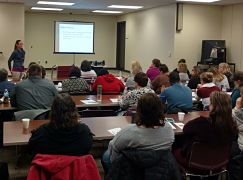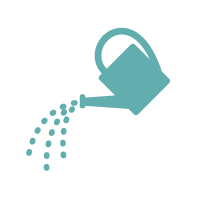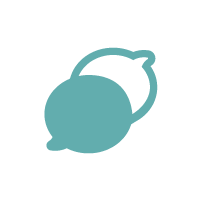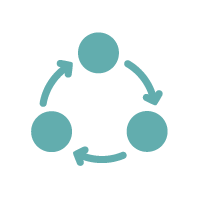Overview
Using a small grant, Rice County Public Health (RCPH), Minnesota, completed a health equity organizational assessment and determined the department needed to strengthen staff understanding and build its capacity to address health equity. To address this need, RCPH created a Health Equity Plan that includes seven practices to build department and community momentum to advance health equity.
Who Took This On
Rice County Public Health, MN
Ways You Can Get Started
- Collaboratively develop an internal plan to establish health equity as an organizational value and priority
- Attend external health equity trainings, then organize an internal staff training to develop a common understanding of key concepts and build momentum for internal change
- Use a framework like the Health Equity Data Analysis to shift how you look at your data
See Advice for Local Health Departments below for more ways to take action.
What Sparked This?
External training helps build internal reflection and interest in health equity
Rice County Public Health (RCPH) is a small, mostly rural, county health department in southeastern Minnesota. RCPH has 46 full-time-equivalent staff (including 25 full-time employees who provide home care and long-term care) and serves 65,000 county residents.
In 2012, RCPH hired a new Director with a background in public health nursing and an interest in the social determinants of health. Like many other local health directors at the time, the new Director understood the importance of social determinants to public health but had little experience in how to integrate social determinants work into the small department’s practice, and had little capacity to take this on.
In early 2017, the RCPH Director sent five staff members to a three-part training, “Fostering Cultural Competence as a Requisite to Inclusion & Health Equity,” offered by Blue Cross Blue Shield Minnesota and the Local Public Health Association of Minnesota Partnership and presented by the Winters Group, Inc. The external training sparked energy and innovation to drive forward a team-wide effort to address health equity.
According to the RCPH Clinic and Community Supervisor, who was one of the five to participate, the training was extremely valuable. It made participants aware of the role of self-understanding in developing cultural competence and introduced them to tools to manage and reduce unconscious bias. Coming back from the training, the five staffers were challenged to engage in frank conversations about what they had learned and how to put it into practice. The RCPH Director supported their enthusiasm, and they began to explore how to integrate cultural competence and equity into their work.
Small state grant provides funding for internal equity assessment
Soon after the training, the Director discovered that the Minnesota Department of Health (MDH) was soliciting local community health board partners to co-submit a grant application to the Public Health National Center for Innovations (PHNCI). Specifically, MDH proposed to develop a Community of Practice with six local community health boards to adopt innovations to advance health equity. The Clinic and Community Supervisor scrambled to write up and submit the grant application which was due the next day.
In May 2017, Rice County was notified that MDH received the PHNCI grant and that Rice County would be one of the six sub-grantees. These six community health boards would each receive approximately $12,000 and were required to:
- Convene a health equity learning community team (including at least one member of senior management)
- Take action to innovate their practice and share lessons learned
- Participate in webinars every other month and attend two in-person training events
- Participate in team coaching over the course of one year
State health department requires health equity data analysis
Since 2009, Rice County Public Health has regularly received funding from MDH as one of the Department’s Statewide Health Improvement Partnership (SHIP) grantees. Formally established in 2009 by Minnesota State Statute 145.986, the SHIP program requires that grantees focus on policy, systems, and environmental (PSE) changes that support healthy behaviors and address health inequities that exist in each grantee’s community. RCPH has used SHIP funds to improve access and remove barriers to physical activity, and to promote healthy eating, breastfeeding, and tobacco education in workplace, school, community, and health care settings.
In 2015, MDH created the Health Equity Data Analysis (HEDA) action tool to create a health equity data assessment process that is easily implemented, builds capacity at the local level, and transforms data practices. HEDA requires leveraging both quantitative and qualitative data on the selected health equity topic as well as ongoing community engagement throughout the data collection and analysis process. (You can learn more about Minnesota’s experience with HEDA on our blog.) After piloting the HEDA tool with 10 SHIP grantees, the state health department began to require HEDA for all subsequent SHIP grantees.
In October 2017, Rice County began to use HEDA as required by its SHIP grant. After interviewing professionals and local community members, RCPH chose the topic of pediatric obesity as its focus because of the apparent differences in weight status by race/ethnicity and because the department had access to both Women, Infants, and Children (WIC) program data and the WIC population. As described below, the HEDA action tool helped RCPH staff dive deeper into a health equity topic, the results of which will be included in their Community Health Assessment.
As county demographics diversify, health equity implications are shifting too
Over the past 20 years, Rice County has experienced a significant racial demographic change due to an increase in immigrants and refugees calling the area home. According to the U.S. Census Bureau, in the past two decades the county has gone from 93% White to 84% White and is now one of the more diverse counties in Minnesota. Notably, the Black/African-American population has increased 308% since 2000.
The influx of new residents, many of whom arrive with large families, has led to a dramatic increase in housing demand. For example, according to the Rice County Housing and Redevelopment Authority, 1% of Minnesota Section 8 households have families with 10 or more members; in Rice County, that figure is 6%.
Compared with nearby counties, Rice County has more unskilled jobs in food processing, warehousing, construction, and other industries, creating a draw to the area, but the county doesn’t have enough housing for the size of the families moving in. Lack of affordable housing is a pressing issue — and one of the leading social determinants of health in Rice County.
Program Description
According to RCPH staff, their department had the “perfect storm” of factors to propel and focus the agency’s work on equity. The external training helped energize staff, the state requirement to conduct a HEDA analysis provided the justification, and the participation in the state Community of Practice provided a support and resource network for staff members who were facilitating the effort. Building on these factors, and as described below, RCPH used the $12,000 state grant to strengthen staff understanding and build internal capacity.
Organizational self-assessment helps identify opportunities to build equity
RCPH started its health equity work by conducting an organizational self-assessment, which they observed had been a starting place for various other health departments. Drawing from the BARHII Organizational Self-Assessment Toolkit and the Anne E. Casey Foundation’s Race Matters Organizational Assessment, RCPH staff in collaboration with MDH staff developed an assessment tailored to Rice County.
With an MDH staff person acting as facilitator, a cross-section of RCPH staff worked through the assessment, discussing ways their current policies and practices helped or hindered the advancement of health equity. The assessment process helped identify opportunities to advance equity and indicated a need to develop a departmental health equity policy. The policy became the guide for how the department will move health equity forward through continual engagement with RCPH staff.
Department develops Health Equity Plan
Not wanting to lose momentum nor to allow health equity to become a discrete project, the Community of Practice team developed a Health Equity Plan to guide future health department activities. To develop the plan, RCPH staff looked at other public health departments’ policies and plans, including those of peer departments elsewhere in Minnesota; in Harris County, Texas; and in Seattle/King County, Washington.
RCPH also drew heavily from Human Impact Partners’ Health Equity Guide, specifically from the “Actions you can take” listed in the strategic practices related to Building Internal Infrastructure. The Clinic and Community Supervisor noted that “we cherry-picked the more feasible actions from the list, which is totally OK because we are just getting started, and we recognize that these initial actions will help lead us to other things.” She also noted that many of the actions and plans had to be adapted because Rice County is much smaller than the counties they were using as examples.
RCPH’s full Health Equity Plan is available here. The Plan includes background, statements of purpose and goals, and descriptions of the core practices to advance health equity, including expectations for those practices.
These are the seven core practices of the RCPH Health Equity Plan:
- Develop staff core competencies to help achieve health equity by providing staff education and dialogue.
- Utilize a hiring process that vets candidates for their sensitivity to and understanding of health equity and/or a willingness to learn more about health equity. This includes efforts to develop a workforce that reflects the demographics of the populations served and the communities facing health inequities.
- Complete a health equity organizational assessment every other year with the goal of integrating health equity considerations into agency policies, practices, and services.
- Use mission, vision, and values statements to communicate the priority of advancing health equity and to articulate the health department’s role in addressing health equity.
- Build authentic relationships with communities experiencing inequities, and, when possible, help them identify and implement community solutions for ending health inequities.
- Regularly collect, analyze, and report data related to health equity and/or social determinants of health.
- Utilize an equity review when considering new policies, practices, or services.
Staff organize Health Equity 101 breakfast training
Recognizing that not all staff were on the same page about the need to advance health equity, the RCPH Community of Practice team decided to organize an in-service Health Equity 101 training for all 51 full- and part-time staff. The RCPH Director approved using some of the $12,000 funding to pay for breakfast for staff and covered the front desk and phones during the training so that all other staff could attend the training.
The PowerPoint presentation for the RCPH Health Equity 101 training is available here and offers the following:
- Definitions of health, public health, and health equity
- A discussion of equity versus equality
- Data and historical examples to illustrate structural inequities
- An outline of RCPH’s proposed approach to health equity
- Examples of a traditional public health approach versus a health equity approach to the agency’s current work
From the training, it became clear that there were many more conversations to be had with staff. One theme that came up repeatedly was how to balance a systems approach with an approach that encourages people to take responsibility for their own health. Staff facilitating the training recognized that many of the questions from staff were related to changing the narrative about what shapes health.
To continue the conversations started at the Health Equity 101 training, the Community of Practice team began to dedicate time in each of the quarterly all-staff meetings to the topic of health equity. At each meeting a new topic would be presented, building on previous discussions and questions.
“Upstream investigation” using HEDA tool raises questions and staff awareness
As part of the SHIP grant, Rice County was required to identify a pressing equity issue in their community and use the HEDA tool to analyze that issue. RCPH chose to explore why Latinx 2- to 5-year-olds were more obese than their non-Latinx peers. According to one staff person, RCPH conducted a “very upstream, why, why, why type of investigation” of pediatric obesity.
Specifically, rather than asking the standard survey questions about access to affordable healthy foods and rates of exercise, RCPH used qualitative methods to get to the root causes of inequities. Recognizing that they didn’t have any Spanish-speaking staff at the time, RCPH subcontracted with Growing Up Healthy, a small nonprofit with Spanish-speaking staff who work to build social capital in five marginalized communities in Rice County. Growing Up Healthy conducted Spanish-language interviews with 14 Latinx residents from across the county, while RCPH staff completed 12 English-language interviews with service providers working with the Latinx community (educators, medical providers, community organizers, etc.). The interviews, which were developed using the Appreciative Inquiry model, were transcribed, with the Spanish ones translated into English, and all interviews were analyzed for themes.
Unlike previous children’s health surveys, which had pointed primarily to the high cost of food as a main factor, the SHIP HEDA identified five main upstream/root factors that disproportionately impacted Latino children’s health:
- Social connections (racism and isolation)
- Immigration policies (mixed-status households, difficult-to-navigate systems, fear of deportation)
- Education (limited language-appropriate resources, lack of time, low parental control)
- Housing and transportation (expense, lack of safety, limited access),
- Employment (unjust work conditions, low wages, long hours, lack of job security).
As HEDA findings were reported back to the interviewees, staff received positive feedback: Community members felt validated and thought the department was truly hearing their concerns.
Outcomes and Impacts
Rice County Public Health’s health equity work is relatively new and still unfolding, but some initial outcomes and impacts can be identified:
-
Staff are asking to be more involved in equity work
As a result of their recent activities, staff are coming forward and saying they want to do more. The current Health Equity Plan allows staff to plug in at the management level, but RCPH is now exploring how to integrate program and office support staff into meaningful equity work as well. For example, it is considering what staff can do within their own work to be more culturally competent or equity focused, like learning Somali greetings and creating linguistically accessible opportunities for participation.
-
Hiring practices are prioritizing multilingual skills
One recommendation from the organizational assessment — and a component of RCPH’s Health Equity Plan — is to hire staff who reflect the county demographics. The Director worked with Human Resources to ensure that bilingual candidates were favored in the hiring process. In the course of 6 months, 3 bilingual and bicultural staff (2 Latinx team members and 1 Somali) were hired; previously there had been none. RCPH staff acknowledge that having bilingual colleagues has positively impacted and deepened RCPH’s relationship with specific communities of color. The new hires are increasingly invited to help with interpretation or translation in other health department activities, which help further deepens department relationships internally and externally.
-
Time is dedicated to equity issues in quarterly staff meetings
Building on the dynamic conversations following the Health Equity 101 training, RCPH now regularly dedicates 15 to 30 minutes of time to discuss health equity topics in all-staff quarterly meetings. This dedicated time helps ensure that the department conversations and actions keep moving forward and helps to build a common understanding of why and how the health department will advance health equity.
-
Collecting qualitative data leads to valuable insights and different conclusions
As a result of using qualitative and open-ended approaches to data collection, the HEDA process led to outcomes that were more profound and more explicitly equity-focused than what otherwise might be expected. For example, a well-respected Latinx community health worker from a partner agency wrote to RCPH after seeing the HEDA results. “Wow,” she wrote, “you are actually saying what the underlying issues are, and not just the typical answer that food is expensive.” She added that she was grateful and glad that RCPH had named issues that few others had identified so explicitly.
-
Other organizations seek collaboration with the health department
The HEDA findings have resonated with other Rice County organizations and highlighted the role that RCPH can play in gathering both quantitative and qualitative data. For example, the county Homeless Prevention Team approached RCPH to ask for and discuss RCPH’s data. One local hospital received a grant to examine its own internal data about populations experiencing disparities, and has offered the data (which are richer and deeper than much of RCPH’s current information) to RCPH to inform its Community Health Assessment process.
-
Staff are cultivating awareness of their own privilege and biases
Finally, the staff training and the experience of looking at county data through an equity lens have helped some staff begin to recognize their own assumptions and lack of awareness about others in their community. For example, many staff had not heard, and some had trouble understanding, that racism and social isolation are primary factors contributing to pediatric Latinx obesity. The RCPH Community of Practice team sees that one of its current roles is to create safe, positive environments for staff to closely examine their opinions and assumptions — and to be gently challenged to see things from a different perspective. The team aims to bring in a greater diversity of perspectives and encourage staff in their professional growth and understanding of health equity.
Future Steps
-
Exploring how to include equity in CHA/CHIP processes
As the department begins its next round of Community Health Assessment (CHA) and Community Health Improvement Plan (CHIP) development, there is consensus that more attention should be given to equity impacts in Rice County communities. Staff plan to explore how specifically to include equity in the CHA and CHIP planning, recommendations development, and implementation processes. Staff note that the CHA in particular is a great opportunity to include more about what creates and advances equity and how not all individuals in their community have the same opportunities.
-
Learning from peers
As the 2017–2018 Minnesota Community of Practice cohort draws to a close, RCPH staff plan to continue connecting with their peers at other local health departments to understand what they are currently doing to address equity issues and identify potential next steps for RCPH. At the same time, RCPH continues to explore how to incorporate more peer-to-peer learning within the department.
-
Building equity into practice within the current budget
RCPH is operating with the assumption that grant money — like the $12,000 received from the state in 2017 — won’t always be available. It takes time, but in leveraging their new Health Equity Plan, agency staff are changing their hiring practices, including equity measures in performance evaluations, assessing the way they look at and describe data, and shifting how they collaborate with community, all within their current job descriptions and budget.
-
Sharing information with decision makers
In the coming months, and using an equity lens, the Rice County team will present findings from their Community Health Assessment process (including HEDA findings) to the County Commissioners as well as to other relevant decision makers to solicit comments and feedback. These presentations will, the team hopes, add momentum to address underlying equity issues.
Advice for Local Health Departments
-
Seek external funding to jump-start internal equity work
Equity has been in our vision statement, but as a smaller agency, it was hard to figure out how to put it into practice given the variety of roles we play. Even though it was a relatively small amount, the $12,000 in grant funding catalyzed our health equity work by allowing/requiring us to step back, reflect, learn, and plan how we could start doing our work differently.
-
Leverage existing equity mandates and resources
We are lucky in Minnesota to have had a state health commissioner who championed health equity, state legislation that requires us to address equity through SHIP, and a state health department that provides resources and technical assistance to advance equity. Given our local context and small size, it has helped immensely to have great partnerships and to have utilized existing resources, such as the Health Equity Guide, to help us advance equity in our department. We have learned that starting small does open the door to other opportunities.
-
Invest time and patience, especially with small staff
As a small agency, we needed our health equity work to fit into the other work we are mandated to do. We don’t have a health equity person on staff, so our health equity work had to develop over time. As the facilitators of this process, we needed time to educate ourselves and to consider what made sense for our agency. Now, with the Health Equity Plan in place, there is more structure by which the work can diffuse among the staff, and there is accountability now that it is part of our policy manual.
-
Don’t let perfection be the enemy of good. Be OK with some vulnerability
Although we need to allow ourselves time to become more aware of race, class, and other dynamics in our work and our community, we also have to challenge ourselves, put ourselves out there, and learn from our mistakes. For example, when developing our HEDA infographic, we labored over the “right” words to use to communicate our message. But at some point, we just had to put it out there, move forward, and learn from the positive and negative feedback that we might receive.
-
Ask peers to help you find your blind spots
We only know what we know — and that means we have blind spots in the work that we are doing. Through the Community of Practice, we realized it’s really important to have peers who can challenge us, for instance by saying, “Yes, that’s a nice start, and what else are you going to do?” Learning what others are doing can help us to see more, do more, be more. At the same time, a peer approach can help expose blind spots and practice talking points. We can challenge and support each other to continually grow.










